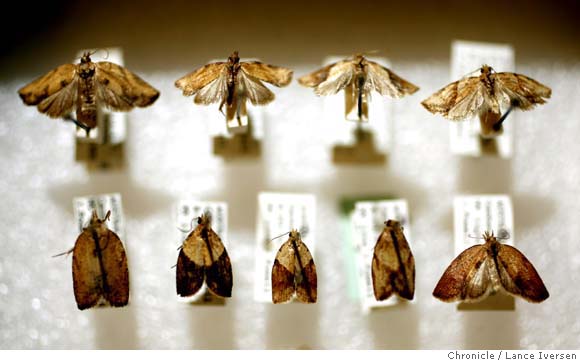Light brown apple moths
Lance Iversen, SF Chronicle
Sunday’s San Francisco Chronicle has a feature about the Australian light brown apple moth, an agricultural pest that recently appeared in the Bay Area. What makes this article by Matt Stannard (with pictures by Lance Iversen) especially enjoyable is that it’s not just about the invader moths – it’s about the man who discovered their arrival, retired UC Berkeley entomologist Jerry Powell. Powell just happened to find an apple moth at his house in Berkeley; he just happened to recognize the nondescript moth from a research stint he did in Australia; and as a UCB professor emeritus, he knew the right people to call about his hunch.
Last summer, Powell found his first light brown apple moth in his UV “insect lure.” He thought he recognized it, but didn’t get around to dissecting it until last fall – shortly before a second apple moth fell into his trap. He sent the specimen to Australia for a second opinion, then called the California Department of Food and Agriculture, which officially verified the moths’ arrival in March. CDFA is maintaining a network of pheromone-baited traps across 47 counties, and has identified several thousand of the moths so far.
The extent of the invasion, especially in Santa Cruz county, proves that the first invader moth didn’t head straight for Powell:
“By the time Jerry collected this thing in his backyard, clearly it had been established in the Bay Area for a long time,” said Brown of the USDA. “The first one that landed in the Bay Area didn’t fly to Jerry’s house.”
Powell says the presence of the light brown apple moth at his home was not a coincidence. It merely suggested that the insect was everywhere to be found.
“I look every night,” he says. “No one else looks in this area, and so if the thing is established here, I’m going to find it before anybody else does.”
Granted, the moth finding Jerry Powell was not such an unusual coincidence. But Jerry Powell himself – someone who collects insects recreationally, on a regular basis, and is qualified to identify them to the genus/species level – is indeed unusual. Most biologists wouldn’t recognize light brown apple moths if they were sitting on our noses. Most non-biologists wouldn’t notice the moths at all.
This story is a lovely throwback to what was best about Victorian science – collectors everywhere, interested in everything, observing and annotating their backyards just as seriously as they might investigate a tropical island. Now, it seems like every field of science is an island unto itself; most of the scientists I know leave their research at work in an effort to “have a life” (or have left research entirely). So although it may have been inevitable that the apple moth eventually wander into a backyard in Berkeley, it wasn’t inevitable that a lone watcher like Jerry Powell be there to meet it. It warms my heart, somehow, that he was.


Nice story. It’s kind of a shame we don’t have natural historians anymore. Contemporary scientific training focuses much much more intensively on concepts and models than on knowing all the species in your little subspecialty.
Well, I don’t think it focuses on general concepts enough – for example, I think any biologist should be able to draw a phylogeny for the major animal taxa, but generally I find geneticists can’t. We’re still obsessive about little details – it’s just that our details are genes and molecules, not species. And since they’re hard to get to, and harder to work with, biology has ceased to be a field friendly to amateurs. . . it’s too bad, really.
This story got picked up by the NYT. Funny, no mention of Jerry though.